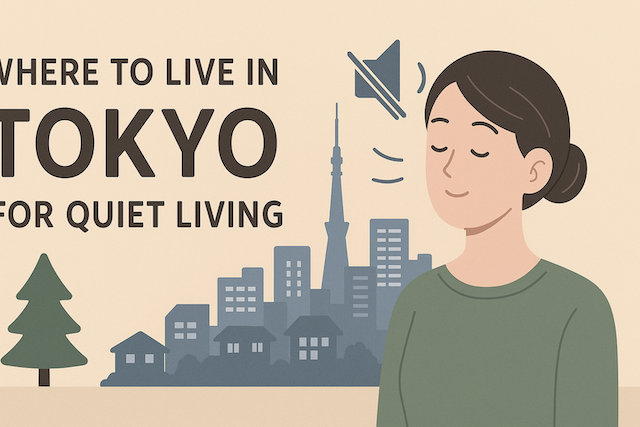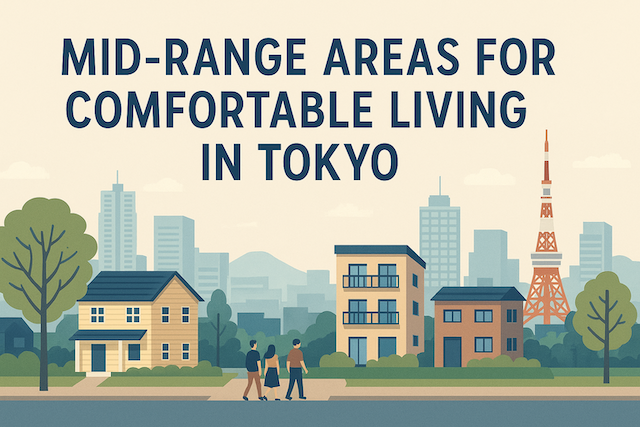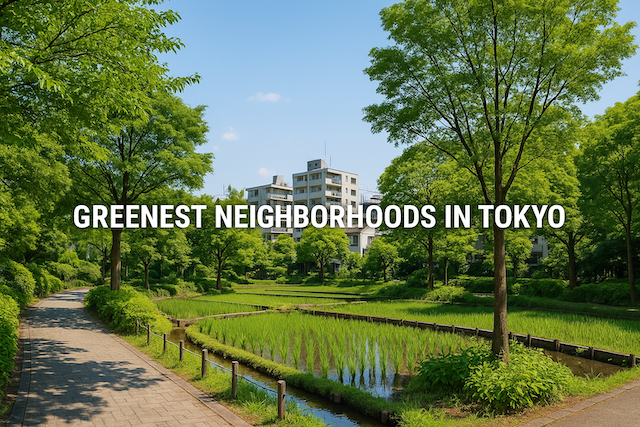Where to Live in Tokyo for Expats [2025-2026 Guide]
Choosing where to live in Tokyo as an expat can be both exciting and overwhelming. The city is massive, with each district offering a unique atmosphere, lifestyle, and convenience. Whether you’re coming for work, study, or long-term relocation, knowing the best areas for foreigners will help you settle in smoothly.
This guide explores the most popular neighborhoods for expats in Tokyo, based on lifestyle, transportation, rent prices, and international accessibility.
1. Overview: Living as an Expat in Tokyo
Tokyo is one of the safest, cleanest, and most efficient cities in the world. However, finding the right place to live depends on your priorities — proximity to your workplace, access to international schools, nightlife, or quiet suburban comfort.
Here are a few quick things to keep in mind when choosing an area:
-
Commute time: Most locals prefer to live within 30–45 minutes of their workplace.
-
Train line access: Tokyo’s public transportation is extensive; living near a major station like Shibuya, Shinjuku, or Tokyo Station offers excellent connectivity.
-
Rent: Prices vary widely. Central Tokyo (Minato, Shibuya, Chiyoda) can be twice as expensive as suburban areas (Setagaya, Nerima, Kichijoji).
-
Community: Some areas have large expat populations, English-speaking services, and international restaurants.
2. Minato-ku – Tokyo’s International Hub
Best for: Diplomats, corporate expats, and families
Vibe: Cosmopolitan, upscale, international
Minato Ward is home to many embassies, multinational offices, and international schools. Popular neighborhoods like Azabu, Roppongi, and Hiroo attract expats who want convenience and global comfort.
Highlights:
-
Hiroo: Known for the international supermarket National Azabu, embassies, and leafy residential streets. Great for families.
-
Roppongi: Famous for nightlife and high-end condos, with easy access to Tokyo Midtown and Roppongi Hills.
-
Akasaka & Azabu-Juban: Blend of modern luxury and traditional charm, with cafes, boutiques, and gourmet dining.
Average Rent (1BR):
-
¥200,000–¥300,000 per month
Pros:
-
Strong expat community
-
Many international schools (e.g., Nishimachi, Sacred Heart)
-
Easy access to major business districts
Cons:
-
High rent
-
Can feel “too international” for those seeking authentic local life
3. Shibuya-ku – Trendy and Central
Best for: Young professionals, digital nomads, creatives
Vibe: Energetic, fashionable, connected
Shibuya isn’t just about the famous crossing — it’s also a vibrant residential area. Districts like Daikanyama, Ebisu, and Yoyogi-Uehara are extremely popular among foreign professionals and creatives.
Highlights:
-
Daikanyama: Tokyo’s “Brooklyn” with boutique shops, cafes, and relaxed luxury.
-
Ebisu: A perfect balance between convenience, restaurants, and style.
-
Yoyogi-Uehara: Calm, residential, and just minutes from Shinjuku.
Average Rent (1BR):
-
¥180,000–¥250,000 per month
Pros:
-
Great nightlife and dining
-
Walkable and trendy neighborhoods
-
Convenient train access
Cons:
-
Limited space for larger families
-
Higher cost of living
4. Meguro-ku and Setagaya-ku – Family-Friendly Suburbs
Best for: Families, long-term residents, quiet lifestyles
Vibe: Residential, green, relaxed
If you prefer a quieter, more local Tokyo experience, Meguro and Setagaya are excellent. These wards are popular among Japanese families and expats who value space, greenery, and calm surroundings.
Highlights:
-
Jiyugaoka: Elegant, European-style streets with cafes and boutiques.
-
Nakameguro: Trendy riverside area famous for cherry blossoms and cafes.
-
Futako-Tamagawa: Great shopping and riverside parks, ideal for kids.
Average Rent (1BR):
-
¥120,000–¥200,000 per month
Pros:
-
Spacious apartments and houses
-
Family-friendly environment
-
Easy train access to Shibuya or Shinjuku
Cons:
-
Longer commute to central Tokyo
-
Fewer English-speaking services
5. Shinjuku-ku – The City That Never Sleeps
Best for: Commuters, nightlife lovers, singles
Vibe: Busy, urban, convenient
Shinjuku offers a mix of entertainment, business, and residential zones. While Kabukicho is Tokyo’s nightlife district, areas like Nishi-Shinjuku and Shinjuku-Gyoenmae offer more livable and quieter spaces.
Highlights:
-
Shinjuku Gyoen Park: One of Tokyo’s largest and most beautiful parks.
-
Takadanobaba: Affordable area near universities, popular among students.
-
Okubo: Tokyo’s “Korea Town,” with many international restaurants.
Average Rent (1BR):
-
¥150,000–¥220,000 per month
Pros:
-
Direct access to major train lines
-
Tons of restaurants and entertainment
-
More affordable than Minato
Cons:
-
Crowded and noisy
-
Small apartments
6. Chiyoda-ku & Chuo-ku – Business and Convenience
Best for: Professionals working in finance, consulting, or corporate HQs
Vibe: Modern, high-rise, business-oriented
These central wards are home to Tokyo Station, Marunouchi, and Ginza — ideal for those who value convenience and luxury.
Highlights:
-
Ginza: Tokyo’s luxury shopping and dining capital.
-
Marunouchi: Surrounded by corporate offices and Tokyo Station.
-
Kanda: A more affordable pocket near Akihabara with great transport links.
Average Rent (1BR):
-
¥200,000–¥300,000 per month
Pros:
-
Walk to work if you’re in finance or corporate offices
-
Excellent train connections
-
High-end apartments
Cons:
-
Limited green space
-
Lacks neighborhood community feel
7. Kichijoji – Best for Quality of Life
Best for: Artists, young families, long-term residents
Vibe: Relaxed, creative, and livable
Kichijoji often tops “Best Places to Live in Tokyo” surveys. Located on the JR Chuo Line, it offers a perfect blend of urban life and natural surroundings, with Inokashira Park right at its heart.
Highlights:
-
Laid-back lifestyle
-
Independent shops and cafes
-
Great access to Shinjuku (20 minutes by train)
Average Rent (1BR):
-
¥100,000–¥180,000 per month
Pros:
-
Affordable compared to central Tokyo
-
Nature and art culture
-
Friendly local community
Cons:
-
Farther from business centers
-
Commute can be crowded
8. Ota-ku & Shinagawa-ku – Near Haneda Airport
Best for: Frequent travelers, expats working in logistics or tech
Vibe: Practical, quiet, suburban
Ota Ward includes Haneda Airport, making it perfect for expats who travel often. Meanwhile, Shinagawa offers easy access to both Tokyo and Yokohama.
Highlights:
-
Omori and Kamata: Affordable and family-friendly.
-
Tennozu Isle: Waterfront development with modern apartments.
-
Shinagawa Station area: Convenient for Shinkansen access.
Average Rent (1BR):
-
¥120,000–¥200,000 per month
Pros:
-
Great transport links
-
Quieter neighborhoods
-
Lower rent
Cons:
-
Less nightlife and dining variety
-
Farther from central Tokyo attractions
9. Edogawa-ku & Nerima-ku – Budget-Friendly Choices
Best for: Students, young families, and expats on a budget
Vibe: Suburban, peaceful, family-oriented
If you’re looking to save on rent while still enjoying Tokyo life, Edogawa and Nerima are solid choices. These areas are well-connected but more residential.
Average Rent (1BR):
-
¥80,000–¥130,000 per month
Pros:
-
Very affordable
-
Safe and quiet
-
Local feel
Cons:
-
Longer commutes
-
Fewer English-speaking services
10. Summary: Best Areas by Lifestyle
| Lifestyle Type | Recommended Areas | Average 1BR Rent |
|---|---|---|
| Luxury & Embassy | Minato (Hiroo, Azabu, Roppongi) | ¥200K–¥300K |
| Trendy & Central | Shibuya (Daikanyama, Ebisu) | ¥180K–¥250K |
| Family-Friendly | Setagaya, Meguro | ¥120K–¥200K |
| Affordable & Local | Nerima, Edogawa | ¥80K–¥130K |
| Business District | Chiyoda, Chuo | ¥200K–¥300K |
| Nature & Relaxed | Kichijoji | ¥100K–¥180K |
| Frequent Travelers | Ota, Shinagawa | ¥120K–¥200K |
Final Thoughts
Tokyo offers incredible diversity in lifestyle and housing. Whether you want a luxury apartment near Roppongi Hills, a quiet home in Setagaya, or a creative base in Kichijoji, there’s a perfect match for every expat.
When choosing where to live, consider your commute, budget, and lifestyle needs — not just proximity to central Tokyo. And remember: no matter where you live, Tokyo’s efficiency and safety make daily life smooth and enjoyable for expats.
FAQs
What are the best neighborhoods in Tokyo for expats overall?
Popular choices include Minato (Hiroo, Azabu-Juban, Roppongi) for an international vibe; Shibuya (Daikanyama, Ebisu, Yoyogi-Uehara) for trendy, walkable living; Meguro and Setagaya (Nakameguro, Jiyugaoka, Futako-Tamagawa) for family-friendly calm; and Kichijoji for quality of life near parks. Professionals working around Tokyo Station often prefer Chiyoda and Chuo, while frequent flyers choose Shinagawa or Ota near Haneda.
How much rent should I budget for a one-bedroom apartment?
In central, expat-heavy areas like Minato, Shibuya, Chiyoda, and Chuo, expect roughly ¥180,000–¥300,000 per month for a 1BR. In residential wards such as Meguro and Setagaya, typical ranges are ¥120,000–¥200,000. Budget-focused areas (Edogawa, Nerima, parts of Ota) can dip to ¥80,000–¥130,000, trading shorter commutes and international amenities for space and savings.
What commute time should I target when choosing a neighborhood?
Many Tokyo residents aim for 30–45 minutes door-to-door. Use your nearest lines—JR Yamanote for a central loop, Chuo/Sobu for east-west, and private lines like Tokyu Den-en-toshi or Odakyu for suburban comfort. If you’ll travel frequently between hubs (e.g., Shibuya, Shinjuku, Tokyo Station), prioritize direct lines and fewer transfers over simply living “closer” on the map.
Is Tokyo safe for expats, and which areas feel most secure?
Tokyo is consistently ranked among the safest big cities. Central residential pockets—Hiroo, Azabu, Daikanyama, Ebisu, Yoyogi-Uehara—offer calm streets, strong lighting, and frequent patrols. Suburban family areas in Setagaya and Meguro are also very secure. Regardless of ward, choose streets with good lighting, proximity to stations, and regular foot traffic for late arrivals.
Where should families with kids consider living?
Setagaya and Meguro are favorites for quiet streets, parks, and larger units. Futako-Tamagawa offers riverside spaces and shopping; Jiyugaoka is walkable and stylish; Yoyogi-Uehara and Hiroo put you near international grocers and schools. Check school commute times, park access, and stroller-friendly sidewalks. Many buildings post house rules—ask about play hours, bicycle parking, and storage.
Which areas suit young professionals or digital nomads?
Daikanyama and Ebisu balance café culture with easy access to Shibuya. Nakameguro offers riverside charm and creative energy. For nightlife and networking, consider Roppongi, while Yoyogi-Uehara gives a quieter base with fast links to Shinjuku. Co-working is abundant near major stations; confirm late-night bus or taxi options if you often work late.
What upfront costs should I expect (key money, deposit, fees)?
Typical move-in costs can total 3–5 months’ rent. Expect a security deposit (often 1–2 months), key money (reikin, 0–1 month, sometimes more), agency fee (usually 1 month plus tax), first month’s rent, and lock-changing or cleaning fees. Some “no key money” listings exist; furnished or serviced apartments may have higher monthly rent but lighter initial costs.
Do I need a guarantor, and what if I don’t have one?
Most leases require a guarantor or a guarantor company (hosho-gaisha). If you lack a local guarantor, landlords often accept a guarantor company for an additional annual fee (commonly 30–100% of one month’s rent in year one, then reduced renewals). Corporate expats may use their employer as guarantor; serviced apartments usually simplify this requirement.
Are English-friendly landlords and agents easy to find?
In expat-heavy districts (Minato, Shibuya, Meguro), many agencies offer English support and can pre-filter listings for foreign-friendly buildings. However, you’ll still see Japanese-first documentation. Confirm English lease translations, maintenance procedures, and how to submit repair requests. If language support is critical, prioritize agencies and property managers with established expat services.
How long are leases, and can I negotiate terms?
Standard leases run two years with a renewal fee (often one month’s rent) if you stay. One-year or flexible terms exist but are less common. You can sometimes negotiate minor rent reductions, early move-in dates, or the removal of key money. Strong applications—steady income, employer letter, and quick decision-making—help your negotiating position.
What should I check in the lease and building rules?
Confirm renewal fees, cleaning charges, deposit deductions, penalty for early termination, and pet policy. Review quiet hours, bicycle and stroller storage, balcony usage, package lockers, and trash rules. Check if curtains, light fixtures, or AC units are included; in some units, you must provide your own. Photograph move-in conditions for smooth move-out settlements.
Are short-term and furnished options available?
Yes. Serviced apartments and monthly mansions provide furnished units with utilities bundled, ideal for 1–6 months. They cost more per month but save on deposits, furniture, and setup time. For 6–12 months, some furnished listings exist via expat-focused agencies. Always verify what’s included (bedding, kitchenware, Wi-Fi speed) and cleaning schedules.
How do utilities and internet setup work?
For standard leases, you’ll open accounts for electricity, gas, water, and internet. Many buildings already have fiber to the unit; you’ll choose a provider and schedule installation if needed. Ask about move-in overlap so utilities are live on day one. In serviced or furnished units, utilities and Wi-Fi are typically included—confirm caps or throttling.
Which train lines matter most for daily convenience?
The JR Yamanote Line connects major hubs (Shibuya, Shinjuku, Tokyo, Shinagawa). The Chuo and Sobu Lines run east–west across central Tokyo. Private lines like Tokyu Den-en-toshi (to Setagaya), Odakyu (to Shimokitazawa and beyond), and Keio (to Chofu) serve popular residential pockets. Minimize transfers; a single direct line often beats a shorter geographic distance.
What if I travel often for work?
Consider Shinagawa for Shinkansen access and rapid trains to Haneda, or Ota Ward if you need quick airport connections. Tennozu Isle and parts of Shinagawa offer modern towers with concierge-like services. Verify first and last train times, early-morning taxi availability, and noise levels if you’re directly under flight paths.
Are there pet-friendly buildings, and where should pet owners live?
Pet-friendly listings exist but are fewer and may require extra deposit or cleaning fees. Setagaya, Meguro, and parts of Ota offer larger units and nearby parks. Check balcony safety, nearby veterinary clinics, and dog run access. Always confirm pet size/breed limits and maximum number of animals before applying.
How does garbage and recycling work?
Tokyo enforces strict sorting rules by ward. You’ll separate burnable, non-burnable, plastics, cans, glass, and sometimes PET bottles. Pick-up days vary; buildings post schedules in common areas. Failure to sort correctly can result in non-collection, fines, or warnings. Ask your agent for an English guide from the local ward office after move-in.
What hidden costs should I anticipate beyond rent?
Budget for management fees (common-area maintenance), renewal fees after two years, fire insurance (often mandatory), initial cleaning fees, and potential key exchange costs. If you buy appliances or lighting, factor delivery and installation. Internet setup or mobile router rental may add to month one. If you cycle, some buildings charge for bicycle parking.
How do I compare noise levels between buildings?
Visit at different times—weekday rush, late evening, and weekend afternoons. Check proximity to major roads, train lines, izakaya clusters, or construction. Reinforced concrete buildings tend to have better sound insulation than wood-framed ones. Corner and top-floor units reduce footfall noise from neighbors, though top floors can be warmer in summer.
What is earthquake preparedness like in Tokyo housing?
Newer buildings follow modern seismic standards and may include base-isolation or damping systems. Ask the construction year and seismic grade, and note evacuation routes and emergency kits. Secure tall furniture, use anti-tip brackets, and store a few days’ supplies. High-rises may sway but are engineered to do so; review building notices after any quake.
Where can I search for expat-friendly listings?
Use international-focused agencies and portals that filter for foreigner-friendly, English-supported properties. Specify target lines, budget, must-haves (dishwasher, oven, storage), and move-in date. For maximum speed, prepare documents: residence card (if applicable), proof of income, employer contact, and references. If you’re new to Japan, serviced apartments are a fast bridge to a long-term lease.
Is sharing an apartment common, and what are the pros and cons?
Share houses are popular for affordability and community, with private rooms and shared kitchens/baths. Pros: lower upfront costs, flexible terms, furnished spaces, and built-in social networks. Cons: reduced privacy, variable cleanliness, and rules about guests or quiet hours. Choose reputable operators with clear house rules and responsive management.
Any tips to speed up my application and secure my top choice?
Decide quickly—good units move fast. Present a clean application: ID, visa/residence status, employer letter, income proof, and preferred move-in date. Offer reasonable flexibility on start dates, request removal of minor fees instead of big rent cuts, and show readiness to use a guarantor company. Polite, prompt communication makes a strong impression.







